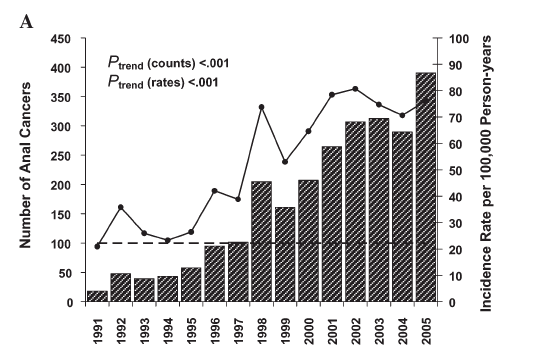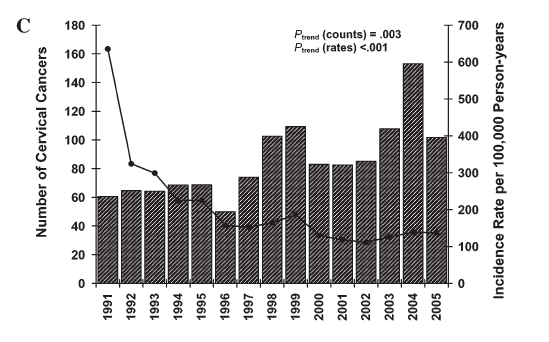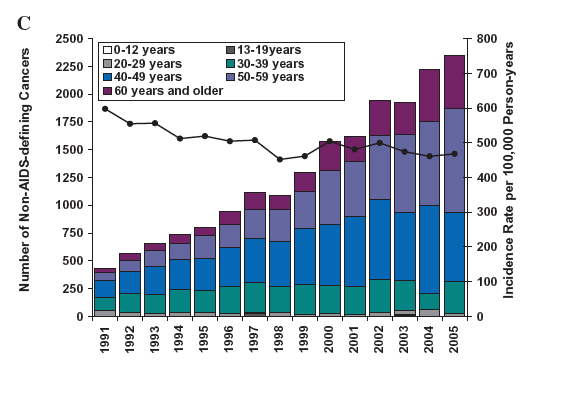| |
Cancer Burden in the HIV-Infected Population in the United States: Anal & Cervical Cancers Increased -Natl Cancer Institute/NIH Report
|
| |
| |
Download the PDF here
from Jules: it seems our priorities are out of step, why are we not discussing the growing challenges to the aging HIV+ patient population; this study highlights only 1 challenge: cancers, I just distributed report from IDSA 2015 finding low rates of screening for women for breast & cervical cancers. Not to mention that the federal govt is NOT at all supporting HCV screening for the general population despite new drugs for HCV with 90%+ cure rates!
"As the HIV-infected population in the United States continues to grow and age, cancer will emerge as an important public health issue........the burden of non-AIDS-defining cancers has grown among HIV-infected people in the United States.....largely been driven by the growth and aging of the HIV population, and for some cancers, by increasing incidence rates
In the United States, during 1991-2005, lung cancer, anal cancer, liver cancer, and Hodgkin lymphoma comprised 50% of all non-AIDS-defining cancers in the AIDS population compared with only 16% of cancers in the general population......Of these four cancers, the largest increase was seen for anal cancer (a greater than sevenfold increase from 1991-1995 to 2001-2005), where cancer was predominantly concentrated among MSM

The growing burden of non-AIDS-defining cancers highlights the need for cancer prevention and early detection among HIV-infected people......HIV-infected women should be screened for cervical cancer according to specific guidelines (36).......efficacy of anal cancer screening with the Papanicolaou test needs to be further evaluated......HIV-infected individuals need to receive screening for other common cancers (eg, colon, prostate, and breast cancer) based on the age-specific recommendations used in the general population......the growing cancer burden points to a continuing need for effective cancer treatment approaches tailored to HIV-infected people, and for the inclusion of HIV-infected individuals in clinical trials
the total cancer burden in people with AIDS has increased since 1998
our results underestimate the number of cancers occurring among people with HIV-only, as a substantial proportion of HIV cases are undiagnosed in the United States (21% in 2006) (34,35) and were not included in our calculations
In the United States, during 1991-2005, lung cancer, anal cancer, liver cancer, and Hodgkin lymphoma comprised 50% of all non-AIDS-defining cancers in the AIDS population compared with only 16% of cancers in the general population (28)
We also observed an increase in the burden of reproductive cancers in women, including cancers of the cervix and vulva (both caused by HPV), breast, and uterine corpus. This increase in the number of cervical cancers occurred despite a decline in the incidence rate. Previous studies have not detected a change in cervical cancer incidence rates over time (1,4). The rise in the burden of reproductive cancers in women is in large part because of the increase in the number of women with AIDS, and as the population of women with AIDS continues to grow and age, these cancers will likely become a rising source of morbidity.

In the AIDS population, the number of AIDS-defining cancers declined sharply between 1991 and 1997 with more gradual decreases in subsequent years. Concurrently, the number of non-AIDS-defining cancers increased steadily from 1991 to 2005 and since 2003, has exceeded the annual number of AIDS-defining cancers
HIV-infected people are at an increased risk of many non-AIDS-defining cancers compared with the general population (1,5-7,9,10). In particular, the incidence rates of lung cancer, anal cancer, liver cancer, and Hodgkin lymphoma (1,2,4,10) are increased. In a meta-analysis (8), these risks were estimated to be increased threefold for lung cancer, 29-fold for anal cancer, fivefold for liver cancer, and 11-fold for Hodgkin lymphoma
Cigarette smoking is also far more common in HIV-infected individuals than the general population (26), contributing to increased rates of lung cancer.
People with HIV infection and AIDS have an elevated cancer risk (1-9). Compared with the general population, HIV-infected individuals have a 3640-fold increased risk of Kaposi sarcoma (KS) caused by human herpesvirus 8 (HHV8), a 77-fold increased risk of non-Hodgkin lymphomas (NHL), some of which are caused by Epstein-Barr virus, and a sixfold increased risk of cervical cancer caused by oncogenic subtypes of human papillomavirus (HPV) (8). These malignancies are AIDS-defining cancers, based on the Centers for Disease Control and Prevention (CDC) definition of AIDS (11). HIV-infected people also have an increased risk of a number of non-AIDS-defining cancers (1-9), including some associated with coinfections (eg, anal and oropharyngeal cancers associated with HPV infection, liver cancer associated with infection with hepatitis B and C viruses, and Hodgkin lymphoma associated with Epstein-Barr virus infection) or with cigarette smoking (eg, lung cancer) (5,6,8,10)."
The estimated counts and standardized rates of non-AIDS-defining cancers among people living with AIDS in the United States by calendar year and age group.

----------
Cancer Burden in the HIV-Infected Population in the United States
JNCI J Natl Cancer Inst (2011)
Meredith S. Shiels, Ruth M. Pfeiffer, Mitchell H. Gail, H. Irene Hall, Jianmin Li, Anil K. Chaturvedi, Kishor Bhatia, Thomas S. Uldrick, Robert Yarchoan, James J. Goedert, Eric A. Engels
Division of Cancer Epidemiology and Genetics, National Cancer Institute, Rockville, MD. Infections and Immunoepidemiology Branch (MSS, AKC, JJG, EAE) and Biostatistics Branch (RMP, MHG); Division of HIV/AIDS Prevention, National Center for HIV/AIDS, Viral Hepatitis, STD, and TB Prevention, Centers for Disease Control and Prevention, Atlanta, GA (HIH, JL); Office of HIV and AIDS Malignancy (KB, RY) and Center for Cancer Research (TSU), National Cancer Institute, Bethesda, MD.
Abstract
Background Effective antiretroviral therapy has reduced the risk of AIDS and dramatically prolonged the survival of HIV-infected people in the United States. Consequently, an increasing number of HIV-infected people are at risk of non-AIDS-defining cancers that typically occur at older ages. We estimated the annual number of cancers in the HIV-infected population, both with and without AIDS, in the United States.
Methods Incidence rates for individual cancer types were obtained from the HIV/AIDS Cancer Match Study by linking 15 HIV and cancer registries in the United States. Estimated counts of the US HIV-infected and AIDS populations were obtained from Centers for Disease Control and Prevention surveillance data. We obtained estimated counts of AIDS-defining (ie, Kaposi sarcoma, non-Hodgkin lymphoma, and cervical cancer) and non-AIDS-defining cancers in the US AIDS population during 1991-2005 by multiplying cancer incidence rates and AIDS population counts, stratified by year, age, sex, race and ethnicity, transmission category, and AIDS-relative time. We tested trends in counts and standardized incidence rates using linear regression models. We multiplied overall cancer rates and HIV-only (HIV infected, without AIDS) population counts, available from 34 US states during 2004-2007, to estimate cancers in the HIV-only population. All statistical tests were two-sided.
Results The US AIDS population expanded fourfold from 1991 to 2005 (96 179 to 413 080) largely because of an increase in the number of people aged 40 years or older. During 1991-2005, an estimated 79 656 cancers occurred in the AIDS population. From 1991-1995 to 2001-2005, the estimated number of AIDS-defining cancers decreased by greater than threefold (34 587 to 10 325 cancers; Ptrend < .001), whereas non-AIDS-defining cancers increased by approximately threefold (3193 to 10 059 cancers; Ptrend < .001). From 1991-1995 to 2001-2005, estimated counts increased for anal (206 to 1564 cancers), liver (116 to 583 cancers), prostate (87 to 759 cancers), and lung cancers (875 to 1882 cancers), and Hodgkin lymphoma (426 to 897 cancers). In the HIV-only population in 34 US states, an estimated 2191 non-AIDS-defining cancers occurred during 2004-2007, including 454 lung, 166 breast, and 154 anal cancers.
Conclusions Over a 15-year period (1991-2005), increases in non-AIDS-defining cancers were mainly driven by growth and aging of the AIDS population. This growing burden requires targeted cancer prevention and treatment strategies.
Discussion
In this study, we demonstrated that the number of cancers (ie, cancer burden) and types of cancers among HIV-infected people in the United States changed dramatically during 1991-2005. In the AIDS population, the number of AIDS-defining cancers declined sharply between 1991 and 1997 with more gradual decreases in subsequent years. Concurrently, the number of non-AIDS-defining cancers increased steadily from 1991 to 2005 and since 2003, has exceeded the annual number of AIDS-defining cancers. Consequently, we noted that the total cancer burden in people with AIDS has increased since 1998.
Several factors contributed to the dramatic increase in the estimated number of non-AIDS-defining cancers. Most noticeably, the size of the AIDS population in the United States increased fourfold from 1991-1995 to 2001-2005, resulting in a substantial growth of the number of people at risk of cancer. Additionally, the cancer burden is compounded by the rising proportion of people with AIDS aged older than 40 years, as the incidence of most cancers increases with age.
Finally, although the overall incidence rate for non-AIDS-defining cancers decreased over time, we observed increased incidence rates for some of these cancers, which, when applied to the population at risk, magnified the estimated number of incident cancers.
The precipitous drop in the number of cases of KS and NHL, despite the increase in the size of the AIDS population in the United States, is likely multifactorial. KS and NHL incidence began to decrease in the early 1990s, possibly because of the use of early combination antiretroviral therapy regimens or, for KS, changes in HHV8 epidemiology (1,24,25). Incidence declined further in 1996 with the introduction of HAART (1,4,14,15). Despite these declines, NHL and KS remain the most common cancers in the AIDS population in the United States, with NHL now more common than KS. Furthermore, for people with AIDS in the United States, the risk of both malignancies has remained elevated during the HAART era compared with the general population (relative risks of 22.6 for NHL and 3640 for KS) (1).
HIV-infected people are at an increased risk of many non-AIDS-defining cancers compared with the general population (1,5-7,9,10). In particular, the incidence rates of lung cancer, anal cancer, liver cancer, and Hodgkin lymphoma (1,2,4,10) are increased. In a meta-analysis (8), these risks were estimated to be increased threefold for lung cancer, 29-fold for anal cancer, fivefold for liver cancer, and 11-fold for Hodgkin lymphoma. Anal cancer, liver cancer, and Hodgkin lymphoma are each associated with coinfections (ie, HPV for anal cancer, hepatitis B and C viruses for liver cancer, and Epstein-Barr virus for Hodgkin lymphoma). The risks of these cancers in HIV-infected individuals are increased because of a greater prevalence of infection (for HPV and the hepatitis viruses) and an inability to control these infections with a suppressed immune system (5). Cigarette smoking is also far more common in HIV-infected individuals than the general population (26), contributing to increased rates of lung cancer. Furthermore, increased risk of lung cancer in HIV-infected individuals may be associated with frequent pulmonary infections, chronic inflammation, or nutrient deficiencies (27).
In the United States, during 1991-2005, lung cancer, anal cancer, liver cancer, and Hodgkin lymphoma comprised 50% of all non-AIDS-defining cancers in the AIDS population compared with only 16% of cancers in the general population (28). The cancer burden attributed to each of these four malignancies increased over time.
The increase in number of lung cancers was restricted to people aged 50 years or older and was likely driven by the growth of the older AIDS population. Of these four cancers, the largest increase was seen for anal cancer (a greater than sevenfold increase from 1991-1995 to 2001-2005), where cancer was predominantly concentrated among MSM. We also observed an increase in the standardized incidence rate of anal cancer during 1991-2005, paralleling an increase in the rates of anal cancer observed in the general US population (29). Previous studies, including our own, have produced conflicting data on whether Hodgkin lymphoma incidence is increasing in HIV-infected people (2,4,30,31). In the present analysis, which included a longer follow-up, Hodgkin lymphoma incidence was stable, but the number of Hodgkin lymphomas increased nonetheless.
Although the number of prostate and colorectal cancers increased over time in people with AIDS, HIV-infected people do not have an increased risk of these cancers compared with the general population (1,2,4,10,32). When compared with the general population, risk in HIV-infected people is decreased by 30% for prostate cancer and by 8% for colorectal cancer (8). Most cases of prostate cancer were among people aged 50 years or older, suggesting that the growth of the AIDS population in this age group was responsible for the increase in the number of these cancers. Furthermore, in contrast to the decline in the incidence rates of prostate cancer observed in recent years among men in the general US population (33), we observed a statistically significant increase in incidence rates of prostate cancer among men with AIDS, which could reflect increases in prostate cancer screening (32). We also observed an increase in the burden of reproductive cancers in women, including cancers of the cervix and vulva (both caused by HPV), breast, and uterine corpus. This increase in the number of cervical cancers occurred despite a decline in the incidence rate. Previous studies have not detected a change in cervical cancer incidence rates over time (1,4). The rise in the burden of reproductive cancers in women is in large part because of the increase in the number of women with AIDS, and as the population of women with AIDS continues to grow and age, these cancers will likely become a rising source of morbidity.
Cancers in people with HIV-only also represent an important part of the cancer burden, contributing 29.0% of all non-AIDS-defining cancers occurring in the HIV-infected population. As in the AIDS population, lung cancer was the most common non-AIDS-defining cancer in people with HIV-only. We were unable to estimate the number of non-AIDS-defining cancers that occurred in the entire HIV-only population in the United States or examine time trends, as our data on this population were more limited than for people with AIDS. Furthermore, our results underestimate the number of cancers occurring among people with HIV-only, as a substantial proportion of HIV cases are undiagnosed in the United States (21% in 2006) (34,35) and were not included in our calculations.
The growing burden of non-AIDS-defining cancers highlights the need for cancer prevention and early detection among HIV-infected people. In particular, programs focusing on smoking cessation (to prevent lung cancer and other cancers) and the prevention and treatment of hepatitis B and C viral infections (to prevent liver cancer) should be targeted toward HIV-infected people (36). HIV-infected women should be screened for cervical cancer according to specific guidelines (36). Given the increasing number of anal cancers in HIV-infected individuals, the efficacy of anal cancer screening with the Papanicolaou test needs to be further evaluated (37). In addition, our results highlight for clinicians that HIV-infected individuals need to receive screening for other common cancers (eg, colon, prostate, and breast cancer) based on the age-specific recommendations used in the general population (38). Finally, the growing cancer burden points to a continuing need for effective cancer treatment approaches tailored to HIV-infected people, and for the inclusion of HIV-infected individuals in clinical trials (39). HIV-related immune suppression and pharmacological interactions with HAART add complexity to cancer treatment, and outcomes are frequently poor (40,41). As individual centers may see few cancers in HIV-infected people, multicenter consortia are needed to comprehensively evaluate cancer treatment protocols in this population.
The major limitation of this study was the limited data for the HIV-only population. As a result, we applied a single rate for each cancer because data were too sparse to estimate rates separately in the strata described previously. Applying one rate assumes that the five registries with HIV-only data were representative of people in the 34 US states and that cancer rates were stable in this population during 1998-2007. Cancer registry data for the most recent calendar years for people with AIDS were also limited, as not all the registries included in the analysis had available data through 2005. The limited data for the most recent years led to unstable estimates for individual calendar years for some cancers. For example, cancer counts appeared to decrease in 2005 for liver cancer, Hodgkin lymphoma, prostate cancer, and colorectal cancer, but variance estimates for these counts were large (data not shown). Further linkages of population-based HIV and cancer registries will allow collection of additional data and continued monitoring of the cancer burden.
The use of HACM Study and CDC surveillance data to estimate cancer counts is the main strength of this study. The HACM Study includes cancer rates from a large and representative sample of HIV-infected people in the United States, and the CDC surveillance data include systematically collected national counts of AIDS cases. These unique data resources allowed us to estimate annual cancer counts in people with AIDS in the United States over an extended time period.
In conclusion, though the risk of AIDS-defining cancers has declined dramatically over the years, KS and NHL remain the most common malignancies in the AIDS population in the United States. Additionally, the burden of non-AIDS-defining cancers has grown among HIV-infected people in the United States. This steep increase has largely been driven by the growth and aging of the HIV population, and for some cancers, by increasing incidence rates. The increase in cancer burden is not limited to cancers known to occur more frequently among HIV-infected people or to cancers with rising incidence rates. As the HIV-infected population in the United States continues to grow and age, cancer will emerge as an important public health issue.
|
|
| |
| |
|
|
|